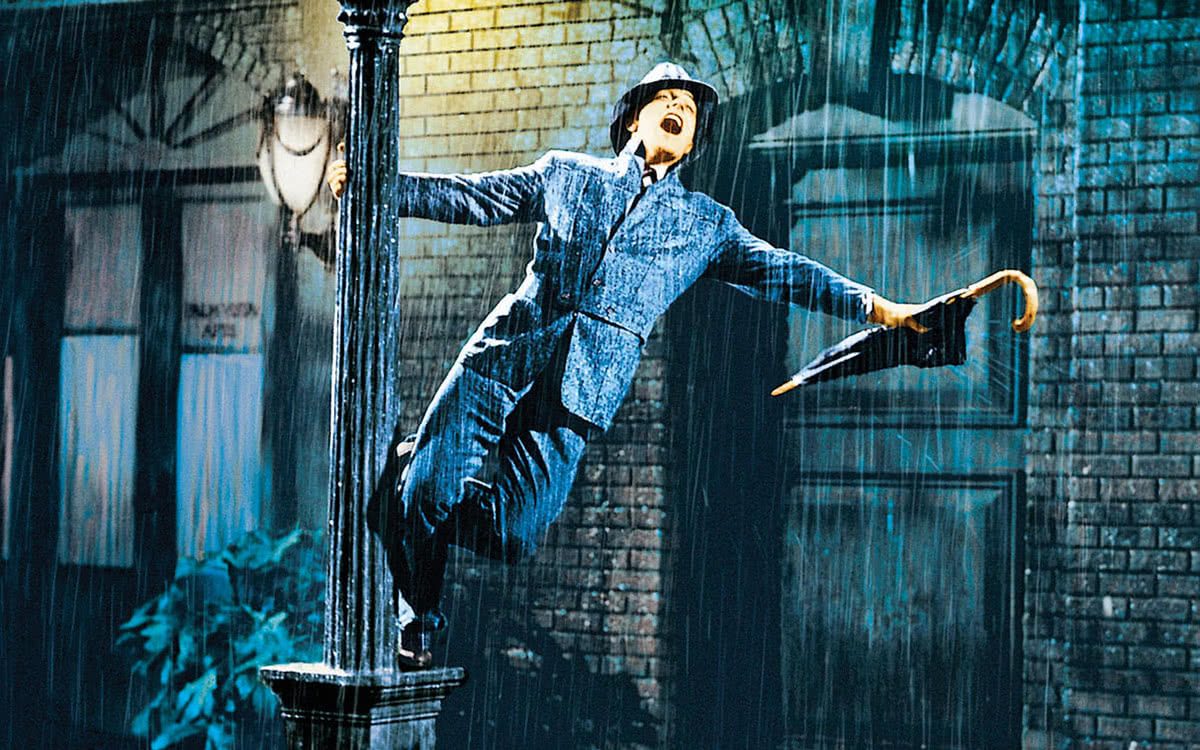Singin’ in the Rain by Gene Kelly, Stanley Donen (Review)

I’m sure that when many folks saw the Volkswagen commercial that featured Gene Kelly popping and locking his way through “Singin’ in the Rain,” they probably cried “foul,” seeing it as one more legend gobbled up by the world of advertising and crass consumerism. And normally, I’d be right there with them. Normally, but not this time, and for two reasons.
First of all, the ad is just really, really cool, seamlessly blending the grace of Kelly with the skills of David Elsewhere (among others). So cool, in fact, that I get a chill everytime the camera zooms in on Kelly’s beaming mug as he sings “I’ve a smile on my face” while his arms move in all manner of liquid, serpentine patterns. And the second reason I’m pooh-poohing the nay-sayers is because that ad, despite all of its commercial intents and purposes, actually inspired me to see the real deal, to see Kelly, Donald O’Connor, and Debbie Reynolds sing, slide, and tap dance their way across the screen.
Singin’ in the Rain seems like a movie that is practically impossible to review. Not because it doesn’t merit serious consideration, or because it’s not a very satisfying and enjoyable viewing. Rather, it’s because the movie has become so tightly woven into the fabric of our pop culture subconsciousness. Everyone is familiar with the titular song, or “Make ‘Em Laugh,” or “Gotta Dance.” Even if we haven’t seen the movie, we know where those lines and melodies came from, and we can probably recite whole scenes because they’ve been parodied, referenced, and copied so many times already.
But that’s precisely why finally watching the movie was such a refreshing, eye-opening experience. To actually see where all of these clichéd lines of dialogue and catchy melodies came from felt rather revelatory. It also told me that people back in the ’50s were a little weird when it came to moviemaking. Or at least, they didn’t consider narrative as a strong necessity when it came to a Gene Kelly musical.
I mean, seriously, can anyone explain to me just what in the heck is with the lengthy “Broadway Rhythm Ballet” sequence? Set within the movie that’s being filmed by our protagonists, it follows Kelly as a young, naive hoofer from the sticks trying to make it on Broadway, only to fall for a femme fatale. Which suddenly transforms into a surreal sequence where Kelly dances with his fantasy woman, who has become a Greek statue-like beauty wrapped in a silk train that soars up into the sky.
It looks almost Dali-esque in places, and it feels like the entire movie grinds to a halt for this one scene — only to remember that there’s a plot about some silent actors trying to survive the transition to talking pictures that it ought to be paying attention to.
Don Lockwood (Kelly) and Lina Lamott (Jean Hagen) are, by all appearances, Hollywood’s most famous couple, a pair of silent film stars whose pictures — and relationship — are the talk of the town. That’s all threatened with The Jazz Singer and the arrival of talking pictures, which threatens to unmask the fact that the two might not act. Making things worse is that Lockwood can’t stand the prima donna Lamott, and the fact that her shrill voice makes fingernails on chalkboards sound like Beethoven is the worst thing of all.
While trying to escape some rabid fans, Lockwood literally falls into the car of Kathy Selden, a young actress who dismisses the dashing Lockwood’s flirting and sticks a needle in his ballooning ego. The whole talking picture fiasco only makes Lockwood’s doubting worse, as not only must he figure out whether he can survive in a world of “talkies,” but he’s also found himself falling for the young Ms. Selden.
Of course, all of this is merely a backdrop for Kelly and Co.‘s rousing musical numbers. While Kelly gets most, if not all, of the recognition for his iconic number in the rain, I personally think Donald O’Connor, who plays Lockwood’s best friend Cosmo Brown, gives the best bang for your buck with “Make ‘Em Laugh.” This hilarious, amazingly choreographed combines Chaplin-esque slapstick with all manner of acrobatics, culminating in O’Connor throwing himself all over the set as he tries to draw a laugh from the audience. Which, inevitably, he does.
On a complete sidenote, O’Connor’s acrobatics reminded me quite a bit of Jackie Chan’s finer moments. Both achieve a sublime mixture of grace and clumsiness, transform common, everyday objects into elaborate and hilarious sight gags, and even risk life and limb as they push a scene to even more delirious heights. (And it ends up costing both of them — both wind up in the hospital as a result of their stunts, and all of our enjoyment.)
At times incredibly silly, full of musical numbers that are literally gibberish (“Moses”) and scenes that serve no real, useful purpose and feel more like giving in to Kelly’s dancing conceits (the aforementioned “Broadway Rhythm Ballet” sequence), Singin’ in the Rain is still absolutely full of starry-eyed, classic, incredibly infectious Hollywood panache. Watching it, you completely understand just why it has become ingrained in our cultural psyche. It’s not something that’s easily definable, I think, other than it contains a perfect synergy between the sights of Kelly et al splashing and dashing away and the sounds of a nostalgic and ebullient score.
It becomes very obvious just why it has been parodied, referenced, and copied so many times over the years. And why it makes for such an incredibly cool car ad.
